In the modern world, digitalization has moved beyond being a trend — it is now a fundamental driver of progress, particularly in education. Today’s universities are expected not only to keep their curricula relevant, but also to create learning environments that are flexible, engaging, and powered by technology.
Yet how achievable is this kind of transformation for Ukrainian universities and vocational colleges?
To explore this question, we conducted a survey of over 60 educational institutions across Ukraine. The main goal was to gather data on their readiness for digital transformation, the tools currently in use, the extent to which artificial intelligence is being applied, and the key barriers hindering the adoption of digital solutions.
It is important to note that the study focused specifically on institutions of higher and professional pre-tertiary education: universities, academies, colleges, and institutes. General education schools, lyceums, and gymnasiums were not included, as the conditions and scale of digitalization in those settings differ significantly.
Digital transformation readiness level
According to a survey of over 60 Ukrainian educational institutions, the majority of respondents consider their institutions to be only partially prepared for digital transformation. Approximately half of those surveyed selected this response. Only 19% did not provide a clear answer, while the remaining 28% stated that their institutions are fully prepared for digital transformation.
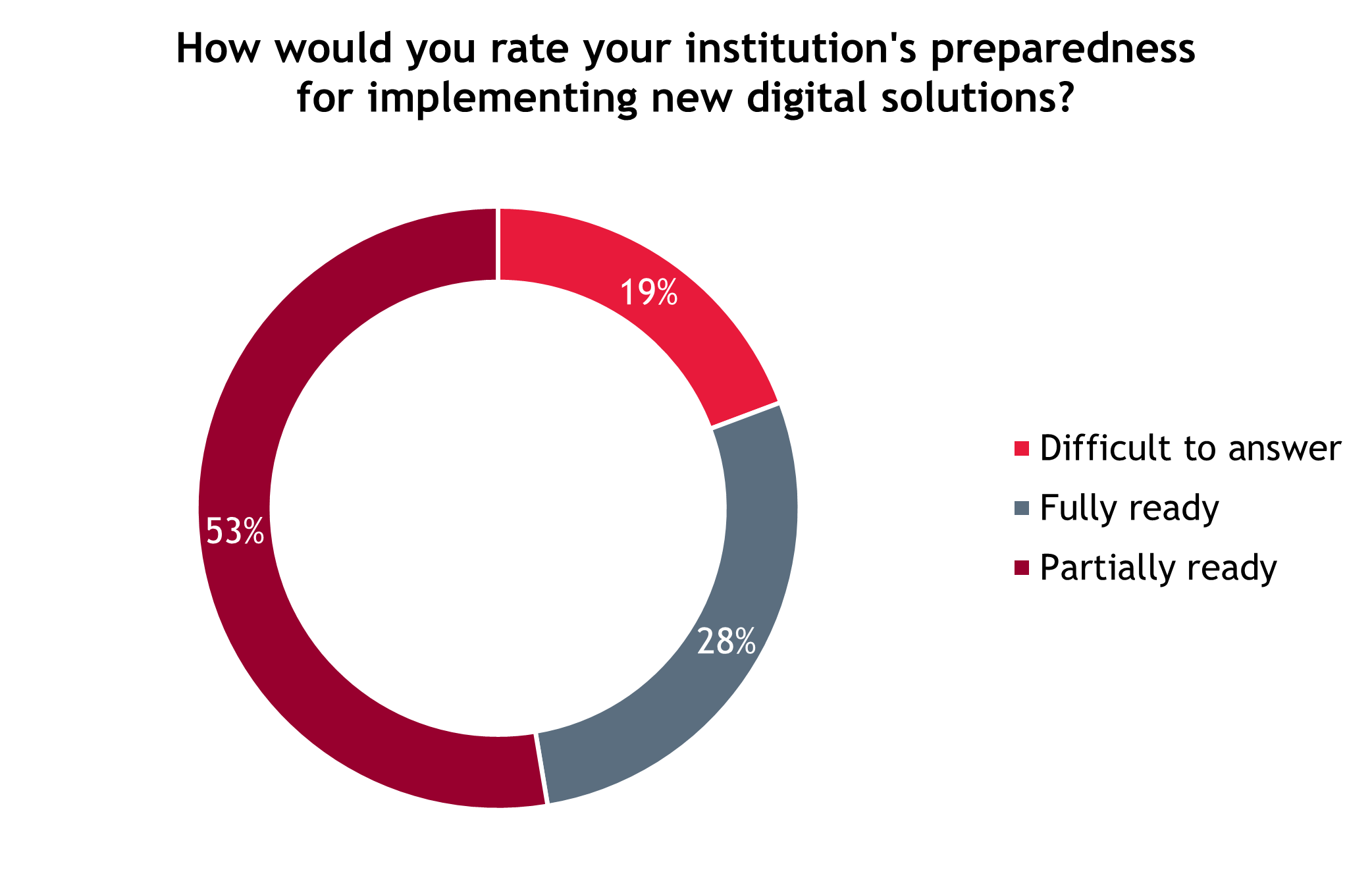
The largest segment consists of those who consider themselves “partially ready” for change, while the shares of those who feel “fully ready” or are “undecided” are significantly smaller. This distribution aligns with expectations for a sector that is still actively learning and adapting to digital innovation.
Common digital tools
Digital tools have already become an everyday part of educational institutions’ operations. Nearly all respondents reported using basic platforms for online communication and learning. The most commonly used are Learning Management Systems (LMS) and video conferencing tools. Many institutions, for example, have implemented LMS platforms (Moodle being among the most popular) that enable them to manage the learning process online. Video conferencing via Zoom, Google Meet, or similar platforms has become a routine tool for delivering lectures, holding meetings, and conducting thesis defenses, and is now used by virtually all institutions.
Cloud-based solutions for collaboration and data storage are widely used. Most universities rely on services like Google Drive, Microsoft 365, or similar platforms to work jointly on documents and back up information. In contrast, ERP systems (Enterprise Resource Planning) and electronic document management systems are not yet as widespread. Only a few large institutions have implemented full-scale ERP solutions or internal information systems such as “Dekanat” (a comprehensive system for managing the educational process). Around one-third of respondents reported having either an ERP system or electronic document management in place, while the rest either operate without them or are in the process of implementation.
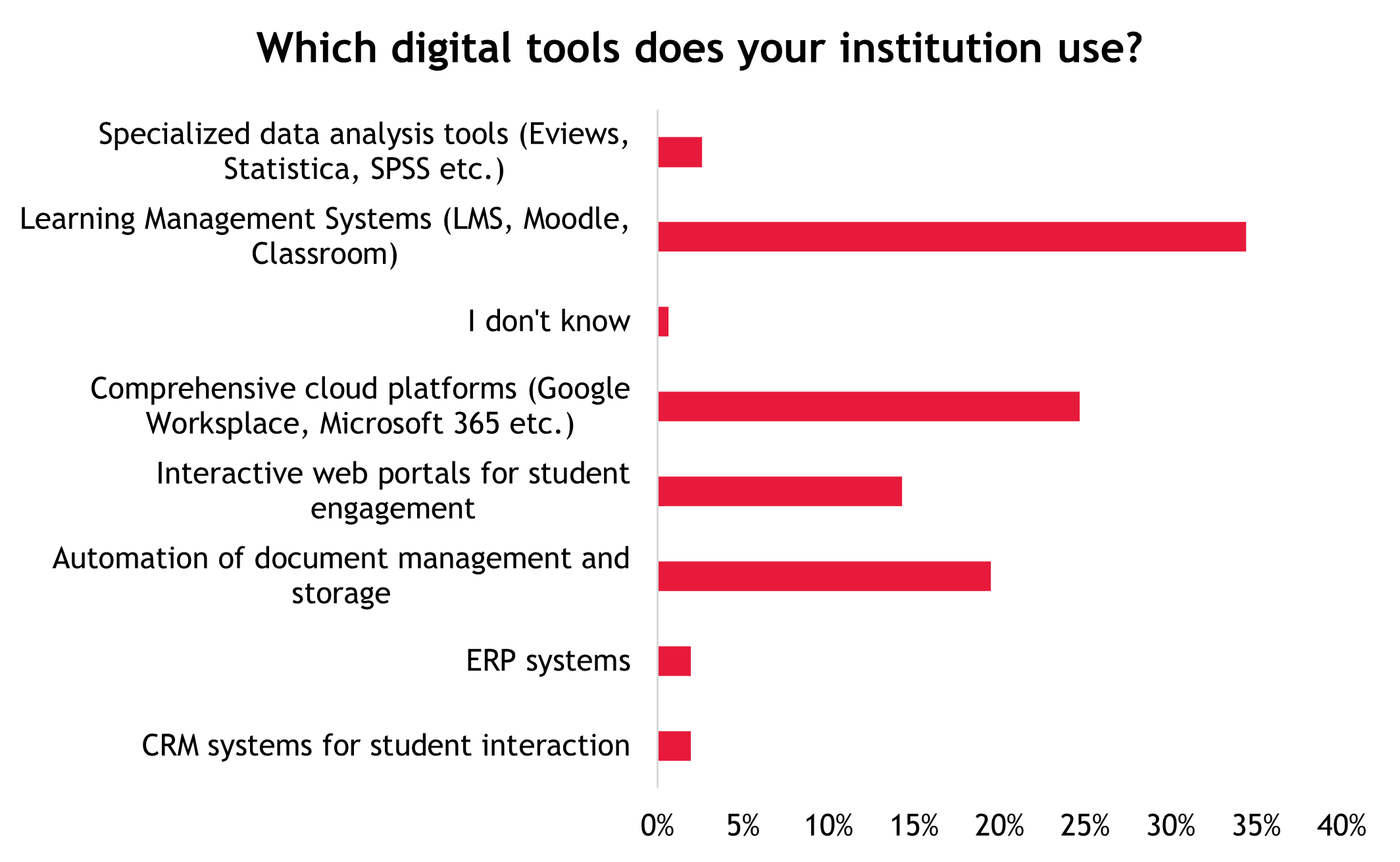
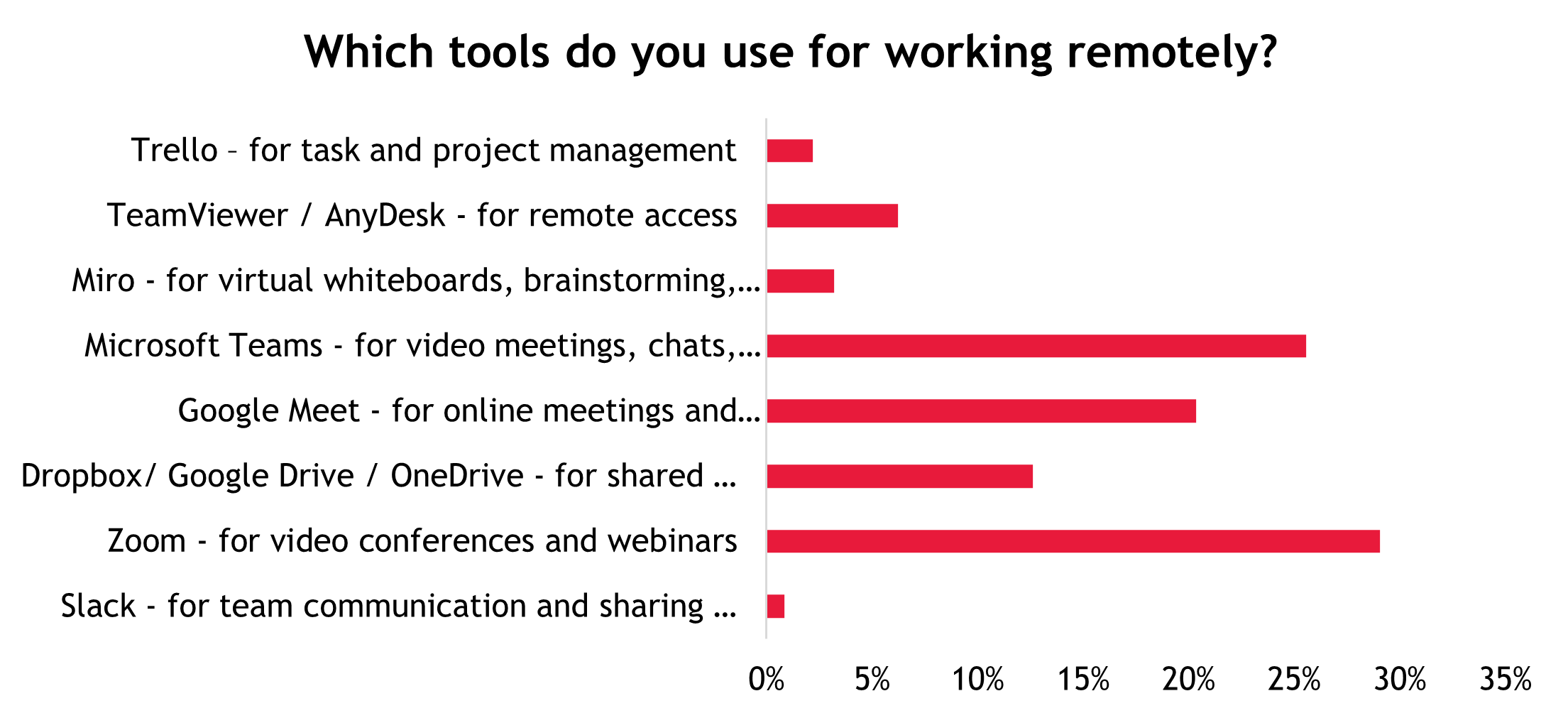
Use of AI in the Educational Process
While Artificial intelligence (AI) tools are still in the early stages of adoption at Ukrainian universities, they have already sparked strong interest. The vast majority of respondents are familiar with modern AI solutions: most notably, ChatGPT. This text-generation tool was mentioned most frequently in the responses. In addition to ChatGPT, some survey participants also mentioned other AI tools, including image generation models like MidJourney, as well as services such as Anthropic Claude and experimental projects by Google. This indicates that forward-thinking educators and IT professionals in the education sector are actively keeping up with emerging AI technologies.
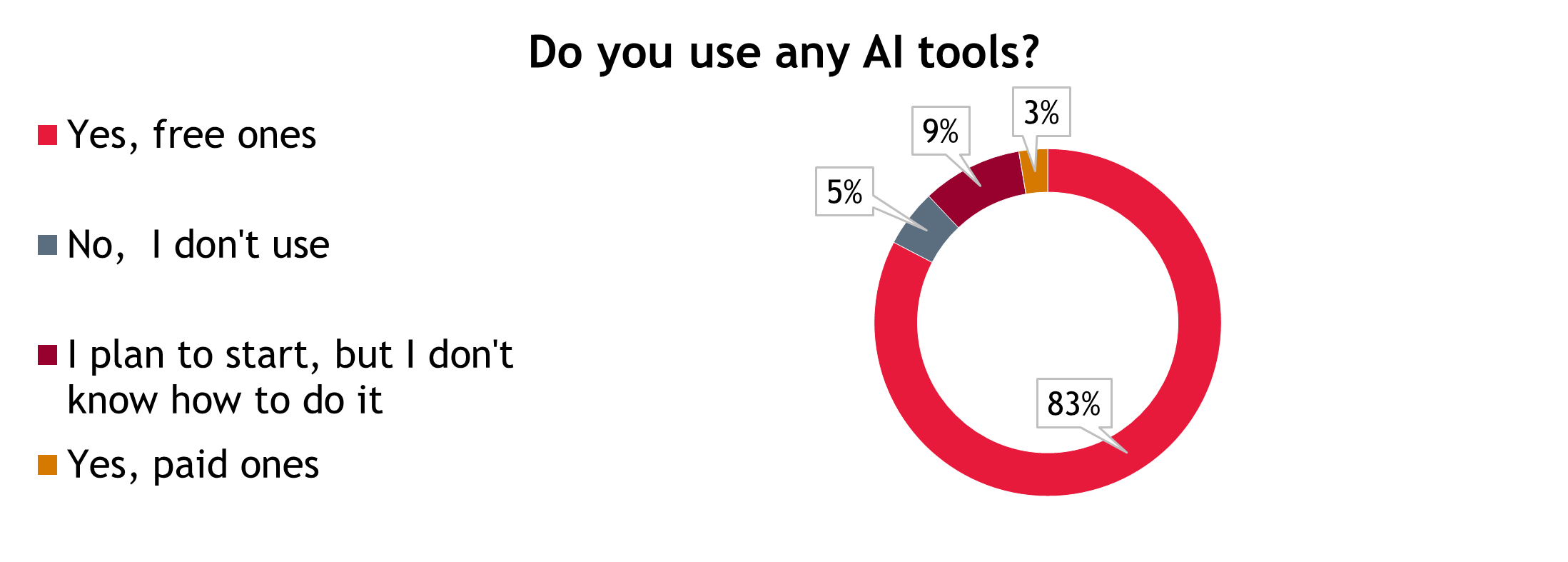
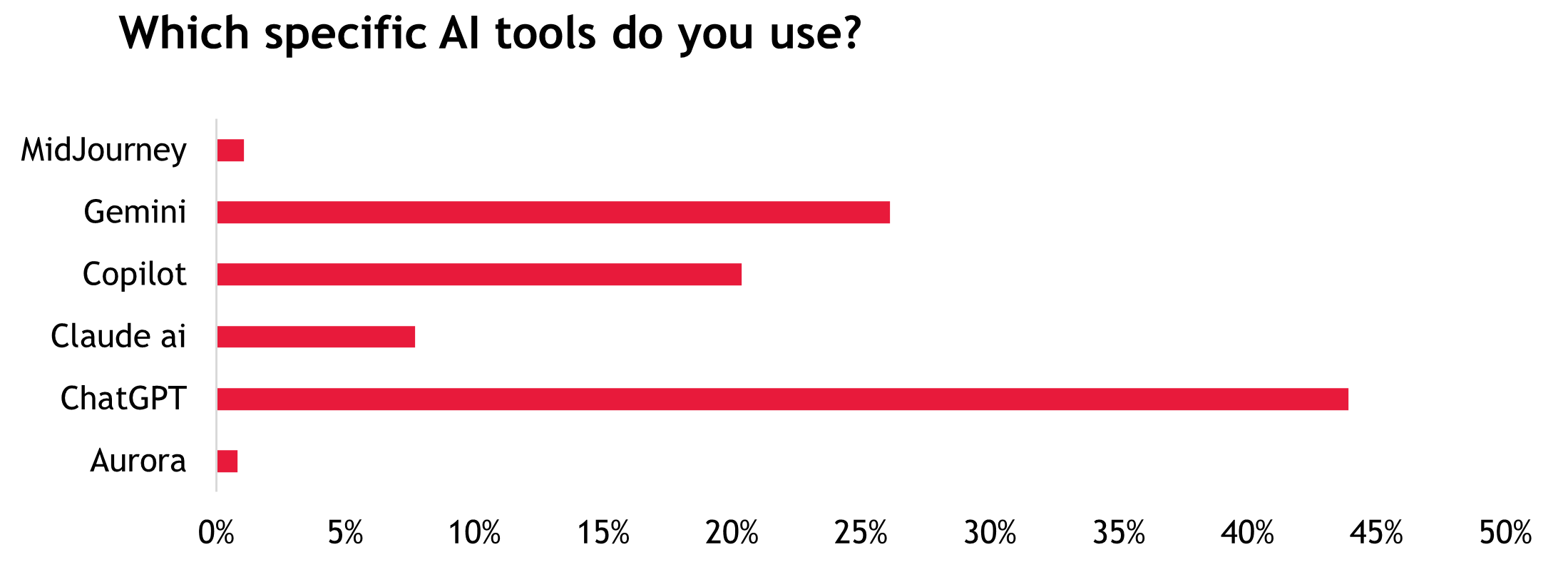
However, the actual adoption of artificial intelligence turned out to be quite widespread. Approximately 83% of institutions reported using free AI tools in either educational or administrative activities, while 3% use paid ones. For example, some are experimenting with ChatGPT to prepare materials or automate routine tasks. Around 9% of respondents plan to implement AI but are unsure how to proceed. Meanwhile, 5% of institutions admitted they are not using any AI tools yet, often due to a lack of expertise or understanding of how AI can be integrated into the learning process.
Key barriers to implementation
Educational institutions surveyed were fairly unanimous in identifying the main barriers to digital transformation. The most frequently mentioned challenges were related to limited resources and insufficient staff training.
- Lack of funding is the key obstacle cited by most respondents. Limited budgets slow down the acquisition of modern equipment, software, licenses for professional platforms. Due to financial constraints, institutions are often forced to rely on free or improvised solutions that do not always meet their actual needs.
- Outdated infrastructure and equipment: Many institutions are in need of upgrades to their hardware and infrastructure. A lack of modern technical resources (computers, networking equipment, and servers etc.) was identified as a significant barrier. As a result, the need to purchase or modernize equipment is a pressing issue for nearly all institutions.
- Lack of IT competencies and need for staff training. Many respondents pointed to a shortage of qualified personnel or insufficient digital literacy among staff. Both faculty and administrative teams often lack the skills needed to effectively use new systems, making large-scale training and professional development essential. Without investment in digital skills, even the tools that are already available may remain underutilized.
- Resistance to change and management support. Cultural and organizational barriers also play a role. Some survey participants noted resistance to change among certain staff members; for instance, some faculty members are reluctant to adopt new technologies or question their effectiveness. Management support is another key factor: if the institution’s administration lacks a clear commitment to digital transformation or fails to develop a coherent strategy, implementation efforts tend to become fragmented.
- Lack of a cohesive strategy. Respondents also pointed out the absence of long-term planning for digital transformation. Many initiatives are implemented selectively, without an overall plan, which reduces their overall effectiveness. Developing a strategic vision for the integration of digital technologies remains a significant challenge for many institutions.
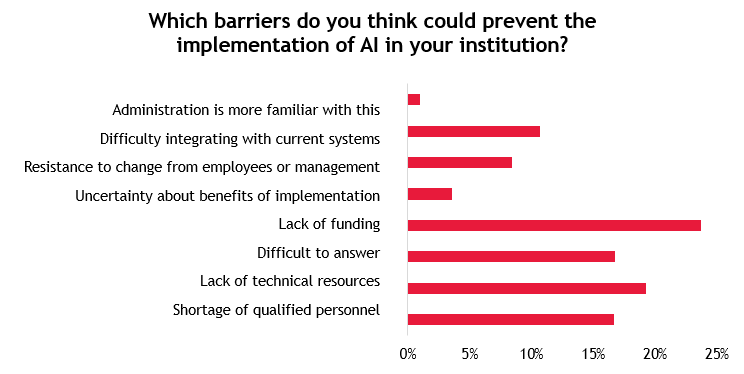
Differences and models of digitalization
By staff category. Academic staff (professors) tend to assess their institutions’ digital readiness more critically, more often selecting the option “partially ready.” They also emphasize practical challenges in implementation: from a lack of trained personnel to technical issues in classrooms. In contrast, administrative staff are more likely to highlight strategic aspects. Their responses more frequently mention the need for funding, management support, and the development of an overall development strategy. At the same time, administrators sometimes express greater optimism about full readiness: some believe that the basic prerequisites for digital transformation (infrastructure, policies) are already in place, and the institution is nearly ready for the transition. This gap in perception underscores the importance of internal communication: successful digitalization requires both management and academic staff to share a common understanding of the goals and challenges involved.
By type of institution. Responses indicate that a university’s profile and scale influence the nature of its digital transformation. Large national universities and institutions with a technical focus tend to take a more comprehensive approach. They are more likely to implement their own IT systems (such as corporate portals, ERP systems for resource management, or specialized learning platforms) and often have more advanced IT infrastructure. In such institutions, there are cases of full or near-full readiness: digitalization is treated as a strategic priority, and significant investments are being made.
Smaller institutions or those with a humanities focus tend to follow a more fragmented path toward digitalization. They often rely on ready-made (and frequently free) solutions: they use standard LMS platforms and cloud services, and rarely develop custom tools. Digital innovations are typically introduced in response to immediate needs (for example, the shift to remote learning during the pandemic) rather than as part of a unified system that integrates all processes. Their level of readiness is generally assessed as partial; these institutions often lack both the resources and the personnel needed to make the leap to full digital transformation.
Typical models of digitalization
Based on these differences, several general models can be identified:- “Digital Transformation Leaders”: These are large universities or institutes that are either fully ready for digital transformation or very close to it. They have implemented a wide range of solutions: from LMS platforms and video conferencing tools to ERP systems and electronic document management (EDM); there is management support and IT development strategy. Although there are not many such institutions, though they set the direction for the entire industry.
- “Pragmatic Experimenters”: The majority of respondents fall into this category. These institutions are partially digitalized: they actively use individual tools (primarily for teaching and communication), regularly test new platforms, but their approach remains fragmented. They recognize the importance of digital transformation and are currently working to overcome key barriers (upgrading equipment, training staff, and developing plans). This group forms the core of Ukraine’s ongoing digital transformation.
- “Late adopters”: institutions that are still in the early stages of digital transformation. They rely on only the most basic technologies, often out of necessity (such as using video calls solely for online classes) and lack a comprehensive digital strategy. These institutions face particularly strong barriers: severe shortages of funding, equipment, and occasionally, not all staff are fully on board. To move forward, they need additional support and resources.
Ultimately, the survey shows that Ukraine’s education sector is steadily moving toward digital transformation, albeit unevenly. Most institutions have already adopted basic digital tools and are aware of their weaknesses. The key priorities in the near term remain: overcoming resource constraints, preparing staff to work with new technologies, and developing a unified digital development strategy. Given the rapid pace of progress (especially in areas like AI) and the experience accumulated by leading institutions, it is reasonable to expect that the gap between “late adopters” institutions and the rest will gradually narrow, and the overall level of digital readiness across Ukrainian educational institutions will continue to rise.
BDO in Ukraine recently hosted a webinar for the representatives of higher education institutions on the topic “Using Artificial Intelligence to Optimise Operations in Educational Institutions”. The event focused on practical AI tools, including solutions for automating translations, drafting presentations, and building a secure digital environment. Special attention was given to Microsoft’s role in providing the technological foundation for digital transformation in education.
For higher education institutions aiming to implement digital transformation effectively, we recommend reaching out to the BDO Ukraine team for professional support.
BDO Ukraine experts provide support in implementing modern Microsoft-based solutions, including AI tools tailored to your institution’s needs, and offer guidance throughout every stage of the digital transformation journey.


